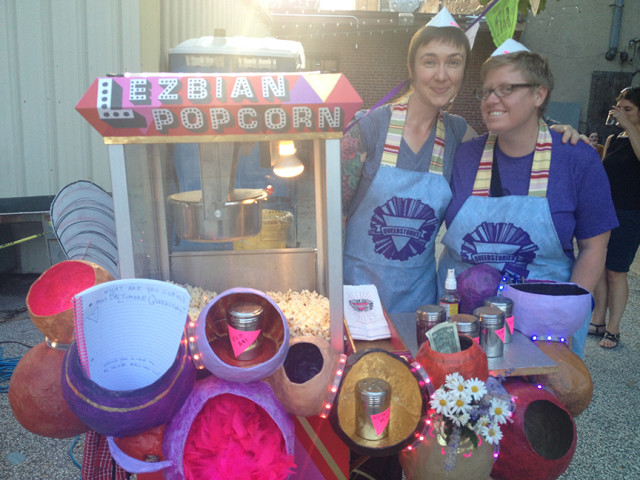
One of the highlights from last year’s Transmodern Festival: the collective Queerstories and their “Lezbian Popcorn” cart, which travels to galleries, festivals, and gay bars serving popcorn in bags screenprinted with tidbits of Baltimore’s queer history.
The best thing about Baltimore is the impressively weird quantity/quality of volunteer-run art festivals that often began as shoestring-budget DIY endeavors but manage to attract international talent. This week alone, the 16th annual High Zero (a world-renowned experimental music festival) wrapped up and the equally-experimental, 12th annual Transmodern Festival kicks off tomorrow.
It’s hard to define exactly what the Transmodern Festival is, largely because “Transmodernism” is a concept fraught with many, overlapping, often-contradictory definitions. Based on a conversation I once had with artist/critic/professor J.W. Mahoney (who has used the term in relation to Yoko Ono’s work in Art in America, for example) and my own experiences with Baltimore’s burgeoning Transmodern scene, I feel tentatively qualified to synthesize this vague definition:
Transmodernism arose as three independent-but-correlating movements in Spain, The United States, and Latin America in the late 1980s/early 1990s. Transmodernism is aware of and informed by Postmodern concerns (globalization, identity politics, referentiality, et al) but approaches those topics with the optimism of Modernism as well as pre-modern belief in the creative agency of the individual and the spiritual.
The festival is also hard to explain because it’s not always curated strictly within the admittedly loose boundaries of the Transmodern. One year might feature video installations, drag queens, punk bands, white-box gallery shows, and immersive political theater; all presented with appropriately little commentary or hierarchy, scattered across venues around the city. Another year’s program might consist entirely of proscenium-staged performance art followed by a dance party. It’s always somewhat of a surprise, and almost always great (Full disclosure: I’ve participated as an artist several times).
This year’s iteration is organized by Laure Drogoul (who has been one of the festival’s driving forces since the beginning), SandyLee Triolo, and Jaime Kauffman. I’m almost hesitant to choose any must-see highlights because half the fun is always getting a little lost. Just try to to take it all in. The full schedule is here. Nevertheless, I feel compelled to recommend a few exceptional projects: Ruby Fulton’s “Unbearable Lightness of Roy” will span multiple real-world and online venues to create a crowd-sourced identity for a fictional person. “NONUMENT 01: McKeldin Fountain” is a collaboration between Baltimore artists Jaimes Mayhew and Lisa Moren and artists from the Slovenian Museum of Transitory Art. They’ll be working to raise awareness about one of the last, most idiosyncratic brutalist public spaces in Baltimore City, which is now threatened by demolition. Apart from the architectural significance of the plaza/fountain, the space is one of the city’s “free speech zones” that was home to the Occupy Baltimore movement, numerous Black Lives Matter protests, and holds a special place in the hearts of many locals (it was here that musicians Blaqstarr and Rye Rye recorded the low-budget music video that propelled them to fame, for example).
There is too much to list, really, but I can’t not mention the Saturday night afterparty, because it’s such a perfect microcosm of what’s great about the overlapping Baltimore nightlife/art scenes. It will take place in the 5th Dimension of the storied H&H Building—a towering warren of artist-run spaces, live-work lofts, and galleries. The event is being hosted/curated by Vague Output, an itinerant party that books talent from seemingly incongruous music scenes around the city—warehouse parties, Bmore club producers, and anomalies like Beastmaster—an awesome transplant from the Detroit techno scene who’s been lugging old electronic music equipment around to perform at noise/experimental shows in Baltimore since 2005.
Keep it impressively weird, Baltimore.


Comments on this entry are closed.